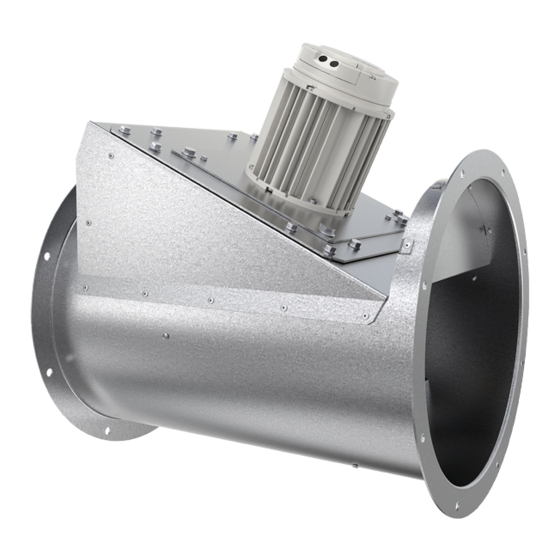Summarization of Contents
1 Introduction
1.1 Product description
Details the thermo centrifugal fan's design, motor placement, and casing specifications.
1.2 Intended use
Specifies the product's application for clean/contaminated air and its limitations regarding media types.
1.3 Document description
Outlines the manual's purpose and requirements for authorized personnel performing procedures.
1.4 Product overview
Visual guide identifying key components of the fan with numbered labels.
1.5 Name plate
1.5.1 Type designation
Provides a breakdown of product names, dimensions, and motor types available for the AxZent series.
2 Safety
2.1 Safety definitions
Defines warning symbols (Warning, Caution, Note) used to convey critical safety information and risks.
2.2 Safety instructions
Provides essential safety guidelines for installation, operation, and maintenance, emphasizing user responsibility.
2.3 Personal protective equipment
Lists mandatory personal protective equipment required for all tasks performed on the product.
4 Installation
4.1 To do before the installation of the product
Pre-installation checklist covering accessories, location suitability, and thorough product examination.
4.2 To install the product
Instructions for correct product positioning, motor orientation, airflow direction, and vibration dampening.
5 Electrical connection
5.1 To do before the electrical connection
Ensures correct electrical connection, clean environment, and verified wiring diagrams before proceeding.
5.2 To connect the product to the power supply
Details power connection steps, including earthing, circuit breakers, and RCD considerations for safe operation.
5.3 Speed controller for EC motors
Information on using 0-10V signals for EC motor speed control and recommended external controllers.
5.4 Motor protection for EC motors
Explains integrated motor protection for EC motors and the procedure for resetting it by power interruption.
5.5 Speed controller for AC motors
Covers AC motor speed control methods, including voltage reduction and frequency converters.
6 Commissioning
6.1 To do before the commissioning
Pre-commissioning checks focusing on installation integrity, electrical safety, and clear air pathways.
6.2 To do the commissioning
Step-by-step commissioning process involving safety switch settings, impeller checks, and gradual speed adjustments.
7 Operation
7.1 To start a product with an EC motor
Procedure for starting EC motor fans, including 0-10V signal setup and safety switch engagement.
7.2 To start a product with an AC motor
Procedure for starting AC motor fans, requiring safety switch activation and external speed controller use.
7.3 To stop the product
Instructions for safely stopping the fan by setting the speed controller and safety switch to OFF.
7.3.1 To stop the product in an emergency
Emergency shutdown procedure: immediate deactivation of the product using the installed safety switch.
8 Maintenance
8.1 Maintenance schedule
Outlines routine and periodic maintenance tasks, specifying intervals for usual and unusual operating conditions.
8.2 To clean the product
Safe cleaning methods for the fan and duct, advising against high-pressure washers and abrasive materials.
8.3 Spare parts
Guidance on ordering spare parts, including contact information and the necessity of using genuine Systemair parts.
9 Troubleshooting
The product does not operate smoothly.
Addresses issues like impeller imbalance, dirt, damage, incorrect rotation, and operational vibrations.
The air output is not sufficient.
Covers causes for reduced air output, including electrical faults, installation errors, and airflow obstructions.
There is unusual noise when the product starts or operates.
Troubleshooting steps for identifying and resolving unusual noises related to duct connections or operational issues.
10 Disposal
10.1 To disassemble and discard the parts of the product
Procedure for safe disassembly and disposal of product parts following WEEE directive and local regulations.
11 Warranty
For warranty claims, send a written maintenance plan...
Details warranty claim requirements, including documentation and adherence to installation and maintenance instructions.
12 Technical data
12.1 Technical data overview
Presents key technical specifications like max air temp, sound pressure, IP rating, and motor details.
12.2 Product dimensions
Provides detailed product dimensions through diagrams and a table for various AxZent fan models.
12.3 Wiring diagrams
12.3.1 Wiring diagrams for speed controllers for EC motors
Illustrates wiring diagrams for EC motors with speed controllers like MTP 10 and MTP 20.
12.3.2 Wiring diagrams for ON/OFF controls for EC motors
Provides wiring diagrams for EC motors using ON/OFF controls with devices like CO2RT-R(-D) and IR24-P.
14 EU Declaration of Conformity
Machinery directive
Confirms compliance with the EU Machinery directive 2006/42/EC and relevant safety standards.
Directive electromagnetic compatibility (EMC)
Confirms compliance with the EU EMC directive 2014/30/EU and associated compatibility standards.
RoHS directive
Confirms compliance with the EU RoHS directive 2011/65/EU concerning hazardous substances.
15 UKCA Declaration of Conformity
Supply of Machinery (Safety) Regulations 2008
Confirms compliance with UK Machinery Safety Regulations 2008 and relevant safety standards.
Electromagnetic Compatibility Regulations 2016
Confirms compliance with UK EMC Regulations 2016 and associated compatibility standards.
The Restriction of the Use of Certain Hazardous Substances in Electrical and Electronic Equipment Regulations 2012
Confirms compliance with UK RoHS regulations on hazardous substances in electrical and electronic equipment.
















Need help?
Do you have a question about the AxZent 500EC and is the answer not in the manual?
Questions and answers